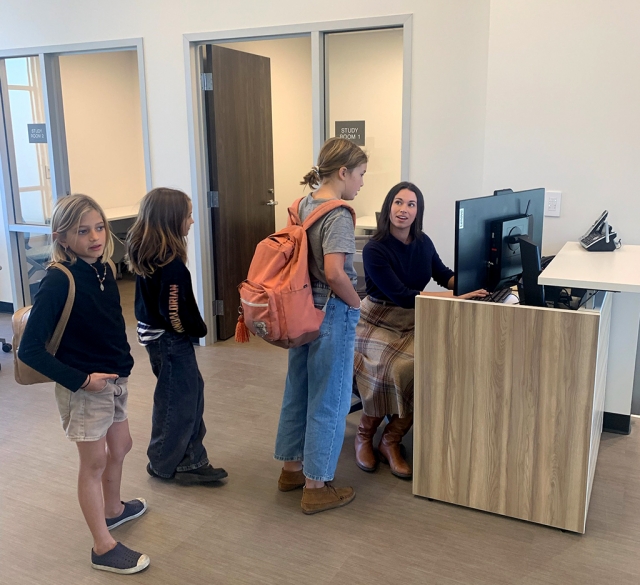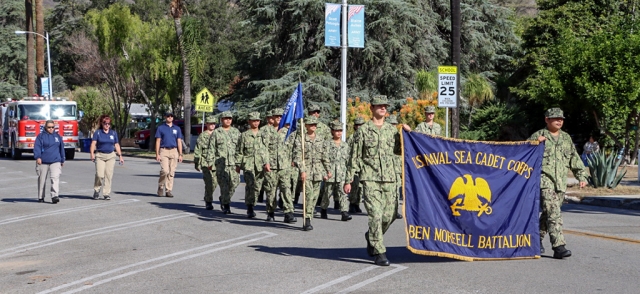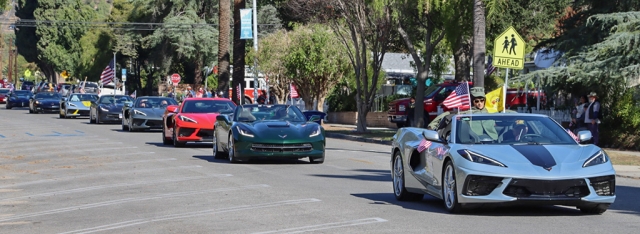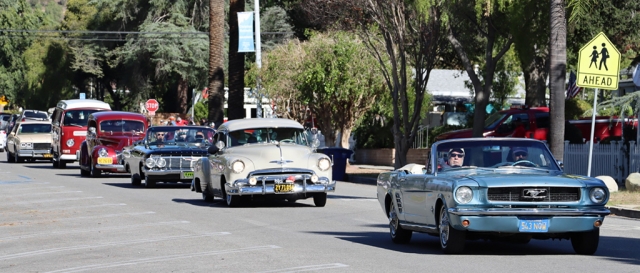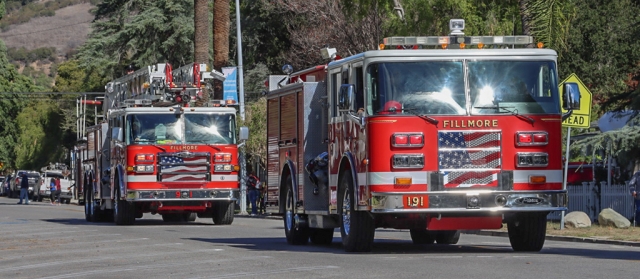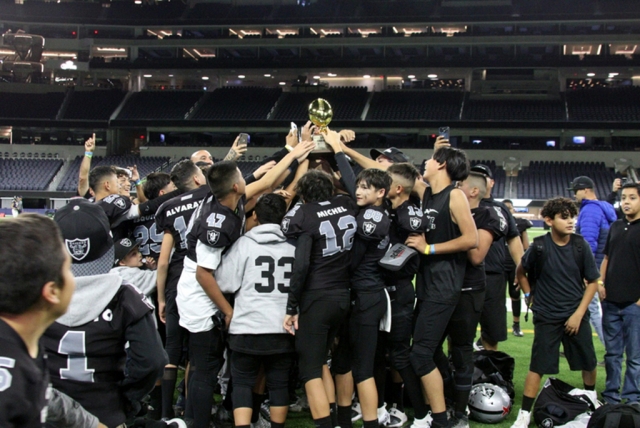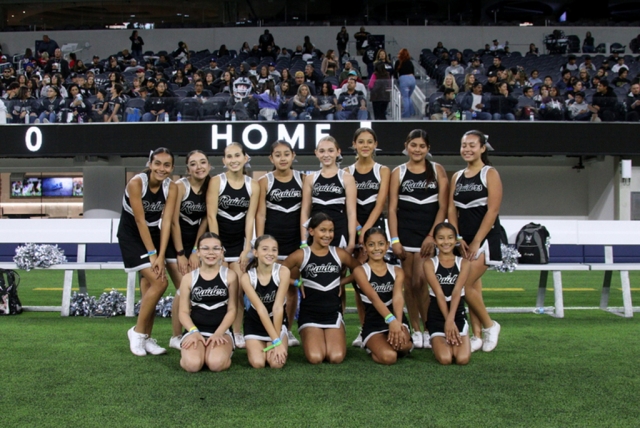|
By Gazette Staff Writers — Thursday, November 24th, 2022
 Friends of the Library President Patti Walker and board member Oralia Herrera were on hand at the grand re-opening of the Fillmore Library, offering baked goods and books as a fundraiser for the organization. Walker has served as president for many years and has been a strong defender of the programs and services Fillmore Library has brought to the community. Enlarge Photo |
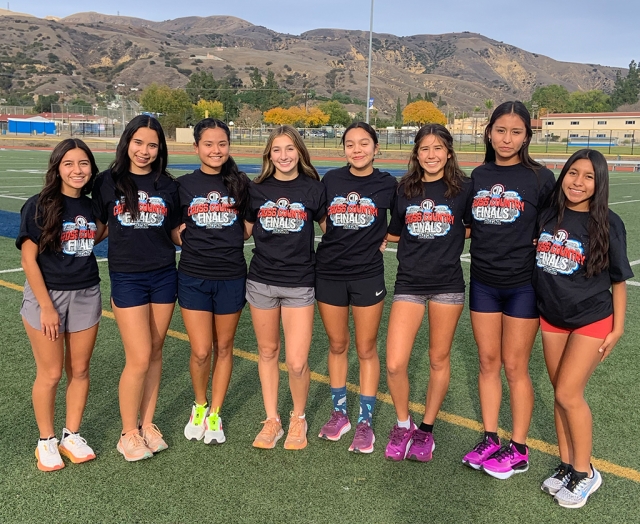 Flashes Girls Cross Country competed at the CIF Southern Section Division 4 Cross Country Championships on Saturday, November 19th, and finished 13th out of 16 teams. Pictured (l-r) are Andrea Laureano, Liliana Montejano, Monique Hurtado, Leah Barragan, Diana Santa Rosa, Alexandra Martinez, Nataly Vigil, and Niza Laureano. Enlarge Photo By Epi Torres — Thursday, November 24th, 2022
On Saturday, November 19th the Fillmore Girls Cross Country team competed at the CIF Southern Section Division 4 Cross Country Championships. The meet was run on the historical, and challenging course at Mount San Antonio College. To qualify for State Finals, the Flashes needed to finish among the top 7 teams in a race of 16 teams. The team was led by sophomore Niza Laureano, who continued to improve throughout this season. Niza finished in 48th place and posted a best time of 19:41.6. Niza was followed by Nataly Vigil 58th in 20:08.4, Andrea Laureano 81st in 21:00.6, Leah Barragan 88th in 21:21.5, Diana Santa Rosa 96th in 21:51.7, Alexandra Martinez 102nd in 22:10.4, and Monique Hurtado 108th in 22:54.5. In the team competition, Fillmore finished in 13th place out of a 16 team field. The top 7 teams will now move on to the California State Meet. |
 Back in 1933 the Turners were early pioneers here who had settled first in Fillmore and later moved to the Sespe and later owned and managed the boarding house (above) on what would become Main St. before and after the arrival of the railroad. Images courtesy Fillmore Historical Museum. Enlarge Photo By Gazette Staff Writers — Thursday, November 24th, 2022
Courtesy Fillmore Historical Museum The following is a first person account of early life at the beginning of settlement of Fillmore found in the archives of the Fillmore Historical Museum. In April, 1933, an early pioneer in Fillmore, Mr. C. C. Elkins, was interviewed about Fillmore’s early years. He had described the simple boarding house, where his family had first stayed upon their arrival on the railroad, as an “up and down boarded house.” Mr. and Mrs. Elbert Bailey Turner were also early pioneers here who had settled first in Fillmore and later moved to the Sespe. They had owned and managed that boarding house on what would become Main St. before and after the arrival of the railroad. Life was hard with few conveniences. It took grit to survive and prosper. Mrs. Turner (Lucinda) who was then living in San Diego took offense to Elkins’ description of her boarding house and expressed her opinion in two letters to the editor, Mr. Wagner, in the April 28th edition of the Fillmore Herald. In the first letter she recalled some earlier history as follows: “Dear Friend Wagner: I am writing some news which are facts. We are the oldest settlers of Fillmore. I won’t hear to it for any one to take the feather out of our cap and put into theirs. I was always proud of that place. There was a lot of nice old settlers. I think of the nice picnics in Kenney’s grove. I know there are just as fine people now in Fillmore. If there wasn’t they would not be there. We are well. Best wishes for you and Fillmore people and friends.” In the second letter she described what she and her husband had to do to survive those early years. “Dear Editor: In our home-town paper, the Fillmore Herald, I read that Mr. and Mrs. C. C. Elkins, Sr. celebrated their 62 wedding anniversary. We wish them health and many more happy anniversaries. The writer of their affair was mistaken in one instance. One of the shacks as he called it was a California built house 30 X 60, 12 rooms 10 feet high, cloth on walls and papered, neatly furnished and clean and Mrs. E. B. Turner was the manager and cook, with hired help. We also ran a livery stable. We had a paying business but it was hard work with many disadvantages. No meat market, no stores or vegetable wagon every day at your door. Our meat was shipped from Ventura by the Hobson brothers. Easly of Santa Paula furnished most of our vegetables. E. B. Turner butchered a hog now and then and Alfred Stone killed deer. He sold the best part to us. I pickled beef and sides of pork to help out. We had a pen of fat chickens, paid 25 cents for a five or six-pound young rooster, so you can see it was not a fool’s job to take care of our little business. I add to this that C. C. Elkins family boarded at our place, the Fillmore Hotel, till he could build a temporary place to live in. In a few weeks he began building a two story building with living room and his store on the first floor. It was needed. E. B. Turner was the first post master of Fillmore. He fixed a front bedroom in our hotel where he took care of the post office for a year or so. Then it was moved to the depot. George Tighe was depot agent and E. B. Turner appointed George Tighe assistant postmaster. Turner said “There wasn’t any money and no honor to work for nothing.” He rented the hotel to George Tighe’s mother for a year.” “Here are some facts and I want to say the editor in Fillmore in 1887 was a 13 year old boy, a son of Mr. Buckston. The family lived at the old ranch house. The paper was two sheets about 10 X 12 inches. George was a rustler for news. A neighbor by the name of Bill Smith came in the hotel. He said our baby is dead. It was one day old. I haven’t any money to pay for a coffin. I told him I could make one. We had some wide redwood boards. I measured the size and shape on the floor of our back porch. In about an hour I had it finished. I lined it with white cambric and oiled the outside. It was a neat piece of work. I read of a man making his own coffin. It would be time thrown away for me to make mine, for I want to be cremated. Mrs. E. B. Turner” In October 1933, C.C. Elkins was being interviewed by Charles Jarrett also for the Fillmore Herald. In that interview he also noted that, “Mrs. Turner had taken offence to hearing her little bungalow hotel described as an “up and down boarded house. He emphasized to the interviewer “Don’t call them shacks. I was bawled out for doing that a while back.” The Turners prospered, moving to a nice two story home on the Sespe. E. B. died September 12, 1936; Mrs. Turner died in June 1945. They had married in Kingman County, Kansas. According to Mrs. Turner, “Ours was the first marriage ceremony ever In Kingman County, Kansas. The justice of the peace was a bit nervous and had to read his book to find out how to tie the knot. It was cold in his dugout office. All he had for fuel was cornstalks. While he was tying the knot his wife broke up corn stalks to keep the place warm.” The Turners came to California on an immigrant train. Coaches were attached to a freight train. They were 10 days making the journey to San Francisco. They then went to Portland by boat, returning to Ventura County by covered wagon.” |
|
By Gazette Staff Writers — Saturday, November 19th, 2022
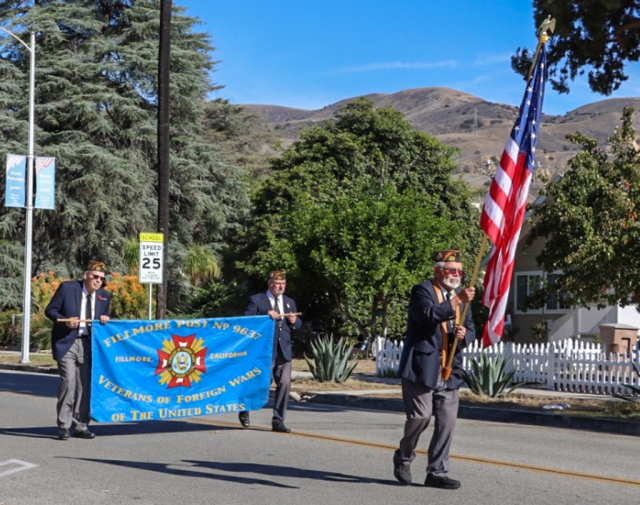 Young and old turned out to honor those who served their country on Friday, November 11th, Veterans Day. Central Avenue was filled with classic cars, motorcycles, Fillmore Fire Engine 91, Fillmore PD, FHS Marching Band, and more. Above, US Naval Sea Cadet Corps (Ben Moreell Battalion) marched in the parade. They are sponsored by the Ventura County Council of the Navy League of the United States. Sea Cadets train aboard U.S. Navy and Coast Guard ships and shore activities, and are authorized by the Secretary of the Navy to wear Navy uniforms marked with Naval Sea Cadet insignia. They participate in parades, color guards, marksmanship training, fireman training, and other activities, as well as community service activities. Inset, Fillmore's own VFW Post 9637, representing the many Fillmore veterans who have proudly served in the military. Photo credit Angel Esquivel AE News. Enlarge Photo |
|
By Gazette Staff Writers — Saturday, November 19th, 2022
Courtesy Fillmore Fire Department The Fillmore Fire Department in conjunction with the Fillmore Fire Foundation is kicking off the annual Holiday Toy Drive this week. Collection drop off boxes for new toys are available at the Fillmore Police and Fire Stations. As part of the Toy Drive, on Sunday, December 4th, the Fire Foundation will be holding the annual Chicken Dinner Fundraiser to collect donations that will used to purchase hundreds of toys for children in the Fillmore/Piru area. A complete chicken dinner meal is prepared for anyone wanting to donate fifteen dollars ($15) that will be used to purchase a new toy. Because of on-going COVID-19 precautions, all meals will be for take-out only and will be available via a contactless drive-thru process, this year the dinner will be held at the Fillmore/Piru Veteran’s Memorial Building, 511 Second St. Dinner will be served from 5 -7 PM. In lieu of a $15 donation, a new toy valued at $15 or greater may be donated. The hundreds of toys purchased from this event will be combined with those that are donated by the Community and then distributed on Saturday, December 17, from 9AM-12 PM at a huge event. If you would like to donate to the Toy Drive/Community Giveaway or would like to purchase tickets/drop off toys, please call 805-815-0328. |
 The Lady Flashes Cross Country team will advance to the CIF Finals to take place Saturday, November 19th at Mt. Antonio College. Pictured are the Lady Flashes Girls team: (l-r) Alexandra Martinez, Leah Barragan, Monique Hurtado, Andrea Laureano, Niza Laureano, Diana Santa Rosa, and Nataly Vigil. Photo Credit FHS Cross Country Coach Kim Tafoya. Enlarge Photo By Epi Torres — Saturday, November 19th, 2022
On Friday, November 11th the boys and girls varsity teams competed on the challenging Mt. San Antonio Cross Country Course. The course consist of two flat loops that measure approximately one mile. After the first mile, there are three challenging climbs that will test the best of athletes. The boys and girls Division 4 competition featured three heats and several top individuals. The top five teams in each heat, and the next fastest team in the 3 heats qualified to CIF SS D4 Finals. The top 8 individuals in each heat not on a qualifying team also qualify qualified. For the Flashes, the girls lined up in the third race of the day at 7:58 a.m. In this second heat 13 teams toed the line, and 7 individuals joined them. Niza Laureano led the girls by placing 12th in a time of 19:44. Niza was followed by Nataly Vigil 21st in 20:23.4, Andrea Laureano 29th in 21:00.8, Leah Barragan 39th in 21:32.9, Alexandra Martinez 43rd in 21:50.7, Diana Santa Rosa 45th in 21:57.7, and Monique Hurtado 68th in 23:40.2. As a result of good grouping, Fillmore placed 5th in a heat of 13, thus qualifying for CIF SS Division 4 Finals. In the Boys Varsity race Eduardo Vigil led the boys with a 19th place finish in 16:38.6. He was followed by Nicholas Hurtado 39th n 17:25.0, Diego Ramirez 41st n 17:27.1, Joshua Estrada 46 th in 17:52.2, Angel Laureano 58th in 18:19.7, and Angel Garcia 65th in 18:32.9. In a heat of 15 teams Fillmore finished in 7th place, thus ending a good season for the boys. Next week, on Saturday, the Fillmore Girls Cross Country will return to Mt. San Antonio College and compete against the top 16 CIF SS D4 teams. On the line is a chance to compete in the State Finals. To qualify for State Finals, they must finish among the top 7 teams. This race is scheduled to start at 7:45 a.m. |
|
By Gazette Staff Writers — Saturday, November 19th, 2022
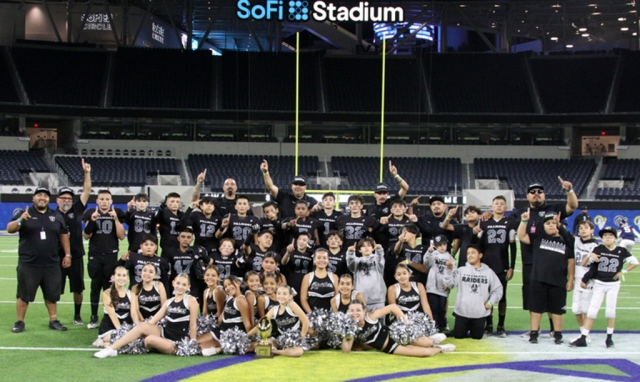 Congratulations to Fillmore Raiders Junior Black D1 for winning Super Bowl XVII at SoFi Stadium on November 11th, 2022! The boys had an amazing season, finishing 10-0. Thank you to all the supporters and sponsors from our City of Fillmore. One Team. One Goal. Photo credit Crystal Gurrola. Enlarge Photo |
|
By Gazette Staff Writers — Saturday, November 19th, 2022
 Thank you Cal Lutheran for hosting Fillmore Unified 3rd – 5th graders at your STEAM event last week. They spent the day touring your campus and the new Swenson Science Center. Our students also got the opportunity to speak with Jose M. Hernandez who shared his journey from migrant farmworker to NASA astronaut. Courtesy Fillmore Unified School District Blog. Enlarge Photo |
|
By Gazette Staff Writers — Saturday, November 19th, 2022
 Fillmore Middle School Principal Carlos Valdovinos recognized Community Liaison Karina Contreras and teacher Jayne Flowers, 6th Grade English/History, for their excellent work during his presentation updating the board and community on programs, activities and initiatives taking place during Fillmore Middle School’s 2022-2023 school year. Courtesy Fillmore Unified School District Blog. Enlarge Photo |
 Barbara and Dale next to their Velocity V-Twin engine plane at Oxnard Airport. Photo courtesy Barbara Filkins. Enlarge Photo By Gazette Staff Writers — Saturday, November 19th, 2022
Written by Carina M. Montoya It is true that big things come in small packages. When I met long-time Fillmore resident Barbara Filkins and learned that she is a pilot and has been flying planes for several decades, I wanted to know more about this accomplished petite lady. Originally from Connecticut, Barbara came to California in the early 1970s to study at Harvey Mudd Collegein Claremont, known for its curriculum that educates talented scientists, engineers and mathematicians. It was at Harvey Mudd where she learned to fly and earned her pilot’s license under the tutelage of Iris Cummings Critchell. Critchell served during World War II as a member of the Women’s Auxiliary Ferrying Squadron (WAFS) and Women Airforce Service Pilots (WASP). She also raced airplanes competitively during the 1950s and together with her husband, Howard Critchell, helped found the Bates Aeronautics program at Harvey Mudd College in 1962. After Barbara obtained her degree in physics, she returned to the East Coast and began working for the aerospace industryin Upstate New York where she met her husband, Dale, who is also a pilot. Barbara’s career soared through the years as her talent and skills in the aerospace industry grew and were in demand within the industry and related industries. A job offer at an aerospace company on the West Coast brought Barbara back to California, where she and Dale decided to make Fillmore their permanent home. They both share a love of flying and have three planes. Dale built one of the planes, a Velocity V-Twin engine,which is a flagship model of the Velocity Aircraft line. Although both have had their share of flying solo, they have flown together many times coasttocoastand often fly somewhere out of town for a weekend getaway. Barbara now teaches aeronautics through distance learning, including flight instruction at the Oxnard and Camarillo airports. In addition to Barbara’s busy daily schedule, she still finds the time for a passionate hobby in an equestrian sport called dressage, which is a form of horse riding performed in exhibition and competition. It is also known as “the highest expression of horse training,” which involves the rider and horse to perform from memory a series of predetermined movements. But wait, there’s more . . .Barbara is a member of the Fillmore Rotary Club and gives of her time for community service by enriching the lives of others locally and around the world, which is at the core of the club’s mission. Next time you see a plane flying above when you’re out and about in town, give it a wave because it just may be Barbara flying over the town. |


